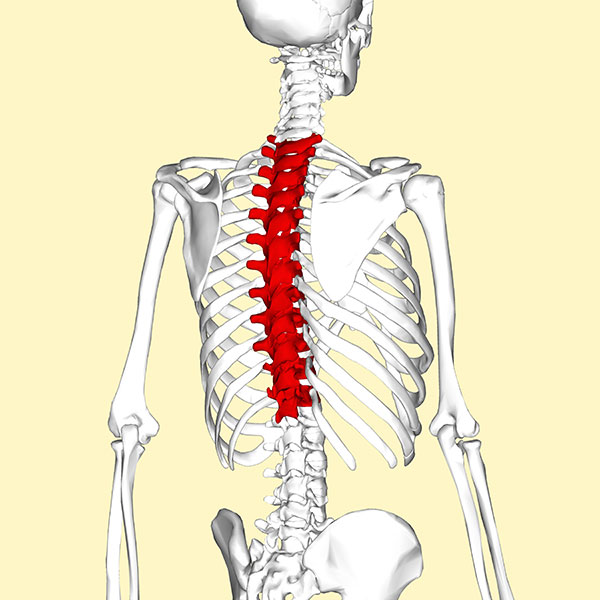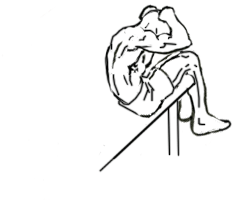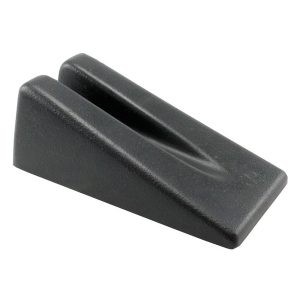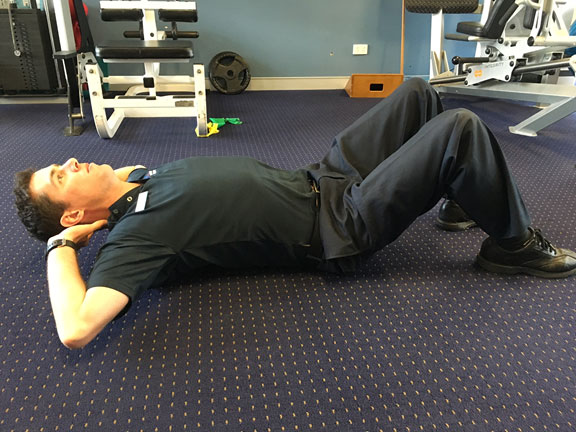The Thoracic Wedge: Easiest Way to Improve Your Posture and Flexibility
Poor posture and a stiff back is one of the most common complaints we treat at Sport and Spinal Physiotherapy. With the modern lifestyle and workplace involving a lot of sitting and not a lot of moving, it is becoming apparent that we as a population are not doing the best job at looking after ourselves and our postures.
Here’s what you will learn about in this article and how the thoracic wedge can help you:
- The thoracic spine (the middle of your back)
- How modern lifestyle is affecting the thoracic spine and posture
- How the thoracic spine and posture affects the rest of your body
- The Thoracic Wedge: Easiest way to address a stiff thoracic spine and improve your posture
The thoracic spine

The thoracic spine is a fascinating, intricate and critical section of the body. It is the middle section of your spine between your neck and lower back, and is made up of 12 spinal segments (vertebrae) and the ribs. Anatomically named from T1 to T12, the 12 thoracic vertebrae are designed to protect our vital organs. They are also made to easily allow us to breathe, provide strong attachment sites for a lot of muscles, and protect important nerves that run to the muscles of our trunk and regulate our vital deep organs. Thoracic mobility can be thought of as the available movement of the middle part of our spine.
Overall, because it has to protect our vital organs, the thoracic spine is stiffer and less mobile than our cervical spine (neck), and lumbar spine (lower back). It has thicker ligaments attached to it, and the very back part of each thoracic part (spinous process) actually points downwards. So there is a limit to how much this part of the spine can bend backwards. Each vertebrae is a wedge shape – slightly larger at the back than the front, which gives the slight natural curve of the thoracic spine (kyphosis).
How modern lifestyle is affecting the thoracic spine and posture
Having a good posture is something we frequently hear, and this term most commonly relates to the position of the thoracic spine.
These days, more and more hours are being spent at desk jobs, on the internet, using our mobile phones, studying and watching TV. Occasionally we might also be on the couch while using tablets or laptops on our lap. These are all positions of thoracic flexion (bent forward) and can all lead to negative changes in posture. Other positions that can contribute include sleeping in the foetal position at night, breastfeeding babies in awkward positions, and driving for extended periods of time.
Have a think about your normal day, most likely you will be sitting while you have your breakfast, sitting while you drive or bus to work, then you find yourself sitting at your desk for the majority of the day. When you go home, you may well find yourself sitting while you have dinner, watch television or work on the computer. The thoracic spine is already understood to become less accommodating and mobile with age, on top of this we also have these other loading issues. This is not beneficial to having a normal, mobile, healthy strong back.
Additionally, certain gym habits can also contribute to a negative posture change, including poor training techniques, and exercises postures – eg a poor deadlift technique, poor rowing technique, sit-ups, and plank positioning.

The above positions tend to lead to an increase in the natural curve of the thoracic spine (kyphosis), and the ability to extend (straighten up) and rotate is decreased.
This stiff thoracic spine cannot only lead to pain in this area, but has been shown to contribute to pain in other areas of the body. A simple search on the topic sees how treating a stiff thoracic spine can have positive effects on neck pain and shoulder pain.
- Thoracic spine manipulation for the management of patients with neck pain: a randomized clinical trial.
- The Immediate Effects of Thoracic Spine and Rib Manipulation on Subjects with Primary Complaints of Shoulder Pain
How the thoracic spine and posture affects the rest of your body:
As discussed above, in a stiff thoracic spine the natural rounded curve increases and the ability to extend (straighten up) and rotate is decreased. This can lead to:
- The neck and head sitting forward (Poke neck posture), which is a common contributor to neck pain and headaches.
- Shoulder pain. Adequate movement of the thoracic spine is required for ideal shoulder function. The full movement of raising your arm above your head requires the upper back to extend (lean back), and if this is not achievable can lead to the shoulder-blade compensating causing shoulder impingement
- Low back pain – To compensate for a stiff thoracic spine, and an increased curve the pelvis often ends up tilting forward increasing the lumbar curve (lordosis). This can be associated with increase pain in the lower back, especially in those with previous disc injuries.
- Pelvic weakness and tight hamstrings – long periods of sitting, and an increased thoracic curve due to sitting can result in tight hamstrings, poor pelvic control and a flat lower back – resulting in poor gluteal (butt) control and pelvic weakness.
- Running difficulties – if a stiff upper back is causing pelvic and butt weakness, this is going to affect any activity that involves running!
- Breathing issues – normal breathing requires the lower rib cage on each side to move like a bucket handle (lifting out to the side). If the thoracic spine is stiff it will mean there will be less movement at the joint where the rib attaches onto the spine, making it more difficult to breath: especially so when bigger and faster breaths are required during exercise.
The Thoracic Wedge: Easiest way to address a stiff thoracic spine and improve your posture
From a work point of view, Michael has covered how to set up your workstation desk to avoid neck pain, back pain and shoulder pain. Nick has also previously posted on the benefits of a sit-stand desk for your posture. However, one of the easiest tools and home remedies for a stiff thoracic spine is the thoracic wedge.

The Thoracic Wedge is a uniquely molded device devised to improve the flexibility of the mid back by using self-mobilisation techniques. The wedge is made from a semi-firm EVA material with a density that provides the right amount of cushioning and firmness. It is designed to lie flat on the ground with the ridges facing upwards, and is made to accommodate the spinous process (bony points of the spine) with sufficient space to facilitate palpation of movement. The user places the wedge on the floor and lays on the wedge, generally with the rounded corners of the wedge in-between the shoulder-blades, though it can be moved so that the ridges are set into various positions on their back. The special ridges on the wedge help to provide a release of soreness and aim to mobilise the thoracic joints. These exercises are performed with care and limited movement to start with, after the user has become accustomed to the wedge more aggressive movements can be performed.

The thoracic wedge is made to keep your back mobile, and it is best used in conjunction with a core stability program (pilates, swiss ball workouts, core stability exercises for example) to provide adequate relief from postural related back discomfort.

It is ideal for those with everyday stiffness caused though prolonged periods of desk work, or even bent-over gardening, and is an excellent tool for higher level athletes looking to gain the maximum benefit from an adequately mobile thoracic spine. Think how much thoracic spine movement is required for swimmers, golfers and any of the throwing or racquet sports!
In summary, the thoracic wedge:
- Is great for keeping your thoracic spine moveable, and improving your posture
- Can be used in conjunction with a core stability program for maximum benefit
- Is ideal for everyday stiffness caused by everyday work and home activities
- And is an excellent tool for athletes.
You can currently get 10% off the purchase price of a thoracic wedge and other posture products at Sport & Spinal Physiotherapy.
Hello, do you ship the wedges overseas as I am in Hong Kong? and how much are they? Thanks a lot.
Hi Philippa
We haven’t set up a shop or shopping cart through our website as yet, therefore aren’t really equipped at this stage to help you. I am sure there are suppliers who would ship internationally. Thanks